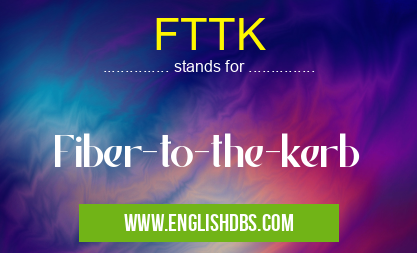What does FTTK mean in COMPUTING
FTTK (Fiber-to-the-Kerb) is a telecommunications technology that provides fiber optic broadband internet access to homes and businesses. It differs from other fiber-to-the-premises (FTTP) technologies in that the fiber optic cable is terminated at the kerb, or roadside, rather than directly to each individual premise.

FTTK meaning in Computing in Computing
FTTK mostly used in an acronym Computing in Category Computing that means Fiber-to-the-kerb
Shorthand: FTTK,
Full Form: Fiber-to-the-kerb
For more information of "Fiber-to-the-kerb", see the section below.
How FTTK Works
With FTTK, the fiber optic cable is typically installed underground and runs from a central distribution point (CDP) to a street cabinet or pedestal near the kerb. From there, copper cables or other types of local loop technologies are used to connect the homes and businesses to the fiber network.
Benefits of FTTK
- Faster speeds: Fiber optic technology offers much faster internet speeds compared to traditional copper-based networks. FTTK can deliver speeds of up to 1 gigabit per second (Gbps) or more.
- Lower latency: Fiber optic cables have lower latency, or signal delay, than copper cables, which improves the overall responsiveness of online applications.
- Increased bandwidth: Fiber optic technology provides significantly more bandwidth than copper cables, allowing for simultaneous use of multiple devices and applications without experiencing slowdowns.
- Improved reliability: Fiber optic cables are less susceptible to electromagnetic interference and other environmental factors that can affect copper cables, resulting in more reliable internet connectivity.
Deployment Considerations
FTTK deployment involves several key considerations:
- Existing infrastructure: Utilizing existing copper infrastructure for the last mile connection can reduce the cost of deployment compared to FTTP technologies.
- Distance to premises: The distance from the kerb to the premises can impact the cost and feasibility of FTTK deployment.
- Local regulations: Permitting and other regulatory requirements may need to be addressed during FTTK deployment.
Essential Questions and Answers on Fiber-to-the-kerb in "COMPUTING»COMPUTING"
What is Fiber-to-the-Kerb (FTTK)?
Fiber-to-the-Kerb (FTTK) is a broadband technology that delivers fiber optic cables to the edge of a property, typically to a distribution point located on the street or sidewalk. From there, traditional copper cables are used to connect the fiber to individual homes and businesses.
What are the benefits of FTTK?
FTTK provides several benefits over traditional copper-based broadband technologies, including:
- Higher speeds: Fiber optic cables can transmit data at significantly higher speeds than copper cables.
- Lower latency: Fiber optic cables have a lower latency, which means that data travels faster between devices.
- Greater reliability: Fiber optic cables are less susceptible to interference and damage than copper cables, resulting in more reliable connections.
What are the drawbacks of FTTK?
The main drawbacks of FTTK are:
- Higher installation costs: Installing fiber optic cables is more expensive than installing copper cables.
- Limited availability: FTTK is not yet widely available in many areas.
How does FTTK compare to other broadband technologies?
FTTK compares favorably to other broadband technologies in terms of speed, latency, and reliability. However, it is more expensive to install than copper-based technologies and less widely available than DSL or cable.
Here is a summary of how FTTK compares to other broadband technologies:
| Broadband Technology | Speed | Latency | Reliability | Availability |
|---|---|---|---|---|
| Fiber-to-the-Home (FTTH) | Highest | Lowest | Highest | Most limited |
| Fiber-to-the-Curb (FTTK) | High | Moderate | High | More limited |
| DSL | Moderate | Moderate | Moderate | Widely available |
| Cable | High | Moderate | Moderate | Widely available |
Is FTTK the best broadband technology for me?
The best broadband technology for you depends on your specific needs and circumstances. If you need the highest possible speeds, lowest latency, and most reliable connection, then FTTK is a good option. However, if you are on a budget or if FTTK is not available in your area, then DSL or cable may be more suitable.
Final Words: FTTK is a cost-effective and reliable fiber optic broadband technology that offers significant speed and performance advantages over traditional copper-based networks. It provides a practical solution for delivering high-speed internet access to homes and businesses in areas where FTTP deployment may be challenging or costly. By utilizing existing infrastructure and carefully considering deployment considerations, FTTK can help bridge the digital divide and provide access to faster and more reliable internet connectivity.
